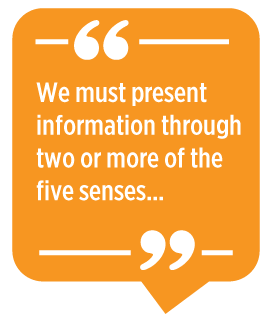Powerful Presentations in the Global Classroom
by Raúl Sánchez and Dan Bullock
 Every speaking situation is an opportunity for
change; when we remind students that they are a catalyst when presenting, we
encourage them to activate their hidden potential. Whether presenting to a
small group or a larger audience, students must be taught to recognize that a
universal goal of any presentation is to create a connection between presenter
and audience that ignites some kind of lasting change.
Every speaking situation is an opportunity for
change; when we remind students that they are a catalyst when presenting, we
encourage them to activate their hidden potential. Whether presenting to a
small group or a larger audience, students must be taught to recognize that a
universal goal of any presentation is to create a connection between presenter
and audience that ignites some kind of lasting change.
How to Supercharge Students’ Presentation Skills
As teachers and trainers, how do we teach
multilingual learners of English to make this connection when delivering a
presentation to an international audience? How do we ensure that the
presentation message will resonate with a mixed audience, especially when the
audience is from different parts of the world with different languages and
different communication styles—all in the same room?
Presenting effectively to a global audience
requires more than just a strong message. A number of strategies help us drive
our message home and yield the results we want, including the following:
- using visual aids to activate the
senses
-
appealing to multiple communication styles to
connect with global audiences
-
employing linguistic patterns for
impact
-
using purposeful body language to highlight key
points
-
achieving clarity with the use of Global English
With key techniques, English language students can
successfully hone public speaking fluency, scaffold presentations using
nonlinguistic strategies, and combine expressive sequences for cognitive
impact.
5 Tips to Sharpen Presentation Skills
Use the following five tips to help students across Common
European Framework of Reference for Languages (CEFR) Levels A1–C2
hone presentation skills that build confidence, enhance fluency, and connect
with mixed audiences from all over the world.
1. Encourage Students to
Enliven Presentations Using Schemata
In the attention economy of today, our brains have
grown even more intrinsically hardwired for stories. We often need to remind
students that this principle still applies in presentations. As a presenter,
our overarching goal is to “light up” the cognitive centers in our listeners’
minds using what we know in our field as schemata.
 In its plural form, schema is
the cognitive framework in our minds that helps us understand and interpret
information more clearly. Suppose a student is delivering a presentation: You
as the teacher hear the presenter tell the audience that they bought a chair
without providing any additional details about that chair (e.g., the color, the
size, the material, etc.). The provided information only tells the audience
that a chair was purchased. However, if the student polled the audience about
the type of chair they imagined in their minds, some listeners may have
pictured a wooden chair, others might have pictured a metal chair, and others,
perhaps even a black leather armchair! What is important to convey to the
student is that the particular image that comes to mind for different audience
members depends on the cultural and personal experiences of each listener in
the space. Therefore, we must present information through two or more
of the five senses to further convey information interculturally and
activate schema for our audiences.
In its plural form, schema is
the cognitive framework in our minds that helps us understand and interpret
information more clearly. Suppose a student is delivering a presentation: You
as the teacher hear the presenter tell the audience that they bought a chair
without providing any additional details about that chair (e.g., the color, the
size, the material, etc.). The provided information only tells the audience
that a chair was purchased. However, if the student polled the audience about
the type of chair they imagined in their minds, some listeners may have
pictured a wooden chair, others might have pictured a metal chair, and others,
perhaps even a black leather armchair! What is important to convey to the
student is that the particular image that comes to mind for different audience
members depends on the cultural and personal experiences of each listener in
the space. Therefore, we must present information through two or more
of the five senses to further convey information interculturally and
activate schema for our audiences.
The most successful presenters use schemata to
achieve a higher focus from listeners and activate learning centers in the
brain, even if the presentation is technical. Having students practice using
vivid and sensory language to convey topics, contexts, and scenarios is a
productive technique for enhancing ways of presenting with the five senses and
activating schema.
Consider a presentation titled “Entrepreneurship in
the Age of Globalization,” which is riddled with jargon-specific terms not
easily translatable across cultures. In this case, you could instruct the
student to include an image or video clip of Steve Jobs of Apple or Jack Ma of
Alibaba on the initial slides to heighten the impact of their message. Visual
aids have the power to focus attention and are a prime place to start for
tapping into schema. As Hurst (1996) writes in The
Handbook of Communication Skills, visual aids “show
information which is not easily expressed in words,” and they “cause the
audience to employ another sense to receive information” (p. 69). Ultimately, we
must encourage students to present information through more than one sense to
create a deeper appeal and impact among the audience.
Other useful ways for students to activate the
schemata of listeners and further immerse the audience in the sensory world of
the topic are to introduce topics by
- playing evocative audio clips,
-
relaying dynamic anecdotes,
-
using compelling video/images,
-
or using relevant props (including hands-on
activities or a 3D model).
2. Help Students Navigate
Between Implicit and Explicit Messaging in a
Presentation
The field of intercultural communication has grown
since Hall wrote The
Silent Language (Hall, 1973) and outlined two frameworks
still in contemporary use for approaching intercultural communication: high-
and low-context communication styles. Helping students be versatile in these
two communication styles enhances presentation delivery for diverse audiences.
According to Hall, Eastern cultures utilize
implicit communication styles, which tend to present information in an indirect
way and gradually “roll out” information with extensive details that build
toward the main message at the conclusion of the presentation. Western
audiences, on the other hand, expect more explicit or clearly defined chunks of
content, with the main message introduced in the beginning of the presentation
and then repeated throughout.
When presenting to culturally diverse audiences,
students need to adjust their message accordingly. If they’re unsure which
style they should use in a mixed audience, we commonly recommend that students
be as explicit as possible about their call to action while continually
rephrasing the takeaway messages. Generally, demonstrating for students how to
revisit shifts in topic from explicit wording to implicit wording and back to
the main message throughout the presentation will provide the necessary aid for
diverse audiences to uptake the information in a clear fashion and retain key
information.
3. Guide Students to Group
Information Into Patterns
Patterns are all around us and even more so with
the prompt patterns of ChatGPT and applied linguistics of other large
language models (Gordon, 2023). In a world made up of patterns, we as
humans try to search for patterns in everything we do, especially when
receiving new information. In fact, “research shows that people retain
structured information up to 40% more reliably and accurately than information
presented in a more freeform manner” (Abrahams, 2014). Teaching students to use
linguistic patterns in messaging remains a key structural element of
intercultural presentations.
When hearing presentations, people tend to group
information into patterns. Therefore, guide students to reinforce their message
by utilizing patterns at the sentence level in their next presentation.
Consider having students group linguistic content, such as their main concepts,
into triads. For example, think of Julius Caesar’s famous phrase: “I came, I
saw, I conquered.” This will not only help students reach their audience better
but also help their audience retain the information.
This same method of speaking in threes (or triads)
has been effective in many notable historical presentations as well. The
technique was used by Abraham Lincoln to advocate for the Emancipation
Proclamation ending slavery in the United States. He utilized a well-known
statement, comprising three elements found in the U.S. Declaration of
Independence: “Life, Liberty and the pursuit of Happiness” (1776, para. 3).
Why is the number three so powerful in linguistic
phrasing, and thus presentations? The answer resides in how our brains are
wired and in our human ability to recognize patterns. Three is the smallest
number needed to create a pattern, making triads very effective in the capacity
for others to retain information. Having students condense and organize their
main points in a presentation into triads allows the audience to process the
information more readily, making it easier for them to remember key
points.
Compounding this concept with other parallel structures
(e.g., “It was the best of times, it was the worst of times,” from A
Tale of Two Cities; Dickens, 1921) allows the audience to mentally
engage and group information more effectively while at the same time
heightening anticipation for the next point. This cognitive technique has the
audience naturally trying to anticipate your next statement.
 4. Help Students Use
Purposeful Body Language and Vocalics to Emphasize Key
Points
4. Help Students Use
Purposeful Body Language and Vocalics to Emphasize Key
Points
People are drawn to movement, and this is pivotal
in effective presentations. Teaching students to move as they speak will not
only capture the audience’s attention but, more important, will also guide
their listeners’ attention toward key messaging. As Kinsey Goman (2014) writes,
“It can be especially effective to move toward the audience before making a key
point and away when you want to signal a break or a change of subject.” This
practical technique can turn any presentation into an impactful force.
Goman also elaborates on the importance of using
the presentation space to reinforce ideas. For example, if a student is
presenting two issues, instruct the student to talk about each issue from a
different physical position, perhaps from different sides of the stage. This
use of body language to mark sections in a presentation can guide a global
audience to key contrasting points and enhance the clear communication of ideas
in the delivery of the presentation.
However, we must caution students to avoid moving
around the stage when they’re making a crucial point because doing so will
diffuse the impact of their message delivery and overall presentation. You have
the most impact when you combine purposeful movement with deliberate physical
pauses—using body language to mark sections in a presentation and then standing
absolutely still when highlighting your presentation’s most important
points.
Furthermore, in addition to body language, we can
instruct students to focus on vocalics by exploring ways
to alter the pitch, rhythm, and volume of their voice throughout a speech. When
making a definitive statement to the audience, instruct students to lower the
pitch of their voice and increase the volume without shouting. Alternatively,
students can increase their pace of speaking to heighten audience interest in
certain presentation sections. In general, when employing intentional voice
patterns throughout a presentation or speech, audiences use speaker cues to
note what content is being emphasized for key takeaways.
5. Help Students Communicate With
International Audiences Using Global English
Much of the world has shifted to using Global
English—which refers to English that has been optimized for a global audience.
Essentially, Global
English (Bullock & Sánchez, 2021) is a purposeful type of
English usage adopted by the global business world that is focused on clear and
plain language (with a limited number of idioms and cultural references).
Students will enhance their public speaking skills in the globalized era when
they become acclimated to using clear diction that is readily understood in a
Global English capacity.
As English has become the primary means of
communication between businesses in diverse countries, the world is moving
toward a new international business English that is practical and useful to
corporations globally. The same remains true for international presentations.
We can help students adjust to this shift by reminding them that nonglobal
English includes idioms, cultural references, acronyms, business-isms, phrasal
verbs, and sarcasm. For example, you can give students phrasing samples in
nonglobal English and then ask them to practice rephrasing the content into
Global English.
Try having students replace the nonglobal English
terms/phrases used in their presentations with more specific/concrete and clear
Global English terms/phrases. Here are some examples:
-
Phrasal Verbs:
Rephrase the phrasal verb in “draw up the contract” to a
single word verb (e.g., “draft the contract”).
-
Business-isms:
Rephrase the business-ism “pain points” with a clear noun (e.g.,
“challenges”).
-
Idioms: Rephrase the
idiomatic phrase “we need their buy in” with a concrete
phrase (e.g., “we need their support”).
Instilling in students an awareness of Global
English during the delivery of their presentations will help them deliver
clearer messages when communicating with an international audience.
Conclusion: Igniting Global Sparklines
Overall,
when delivering a business presentation, whether that is online or in person,
we must encourage students to reflect on how someone from another culture might
interpret it. Being mindful of cultural considerations and implementing these
five tips can lead multilingual learners of English to deliver successful
presentations that ignite lasting change.
References
Abrahams, M. (2014). 6 tips presentations
memorable for making. Stanford Medicine. https://med.stanford.edu/content/dam/sm/faculty-diversity/documents/Site_Content/Making%20Presentations%20Memorable_Matt%20Abrahams.pdf
Bullock, D., & Sánchez, R.
(2021). What’s the best way to communicate on a global team? Harvard
Business Review. https://hbr.org/2021/03/whats-the-best-way-to-communicate-on-a-global-team
Dickens, C. (1921). A tale of two
cities (H. Dunn, Illus.). Cosmopolitan Book Corporation.
Gordon, R. (2023). 3 questions: Jacob Andreas on
large language models. MIT News. https://news.mit.edu/2023/3-questions-jacob-andreas-large-language-models-0511
Hall, E. T. (1973). The silent
language. Anchor Press.
Hurst, B. (1996). The handbook of communication
skills (2nd ed.). Kogan Page.
Kinsey
Goman, C. (2014). 10 simple and powerful body language tips for 2014. Forbes. https://www.forbes.com/sites/carolkinseygoman/2014/01/02/10-simple-and-powerful-body-language-tips-for-2014/?sh=157db904610c
Raúl
Sánchez is an award-winning clinical assistant professor and the
corporate program coordinator at New York University’s School of Professional
Studies. He is the coauthor of How
to Communicate Effectively with Anyone, Anywhere (Career
Press), which received the Axiom Business Book Award. In addition to a TEDx
Talk, he has delivered corporate trainings for Deloitte and the
United Nations. Raúl was awarded the NYU Teaching Excellence Award and
specializes in linguistics and intercultural business
communication.
Dan
Bullock is a language and communications specialist/trainer at the
United Nations Secretariat, training diplomats and global UN staff. He is the
coauthor of How
to Communicate Effectively with Anyone, Anywhere (Career
Press) which received the Axiom Business Book Award. In addition to a TEDx
Talk, he has also served as faculty teaching business communication,
linguistics, and public relations within the Division of Programs in Business
at New York University’s School of Professional Studies.